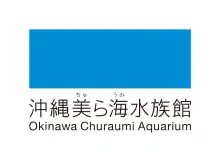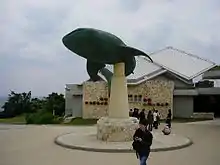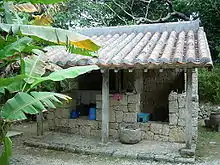Okinawa Churaumi Aquarium
The Okinawa Churaumi Aquarium (沖縄美ら海水族館, Okinawa Churaumi Suizokukan) is located within the Ocean Expo Park in Okinawa, Japan. It welcomed its 20 millionth visitor on 30 March 2010[3] and is a member of the Japanese Association of Zoos and Aquariums (JAZA). It was the largest aquarium in the world until it was surpassed by the Georgia Aquarium in 2005. The aquarium has the theme of “Encounter the Okinawan Sea”.[4]
 | |
 Okinawa Churaumi Aquarium Front Entrance

| |
| Date opened | 1 November 2002 |
|---|---|
| Location | Motobu, Okinawa, Japan |
| Coordinates | 26°41′40″N 127°52′41″E |
| No. of animals | 26,000 |
| No. of species | 740 |
| Volume of largest tank | 7,500,000 litres (1,981,000 US gal) [1] |
| Total volume of tanks | 10,000,000 litres (2,642,000 US gal) |
| Annual visitors | 3.5 million + |
| Memberships | JAZA [2] |
| Major exhibits | 77(Main tank) |
| Website | oki-churaumi |
History
In 1975, the World's Exposition or World's Fair was held in Okinawa, Japan at the Ocean Expo Park. Afterward, the park began to lose tourism and it was believed that a new aquarium would help revive the area and celebrate Okinawa's marine tradition. The aquarium was designed by Yukifusa Kokuba and was opened on 1 November 2002.
"Churaumi" was selected as the name of the aquarium by public vote amongst Japanese people. "Chura" means "beautiful" or "graceful" in the Okinawan language, and "umi" means "ocean" in Japanese.
Aquarium

The public aquarium is a part of the Ocean Expo Park located in Motobu, Okinawa. The aquarium is made up of four floors, with tanks containing deep sea creatures, sharks, coral and tropical fish. The aquarium is set on 19,000 m2 of land, with a total of 77 tanks containing 10,000 m3 of water. Water for the saltwater exhibits is pumped into the aquarium from a source 350 m offshore, 24 hours a day.[5]
The main tank, called the Kuroshio Sea, is 35 metres (115 ft) long, 27 metres (89 ft) wide and 10 metres (33 ft) deep.[6] It holds 7,500,000 litres (1,981,000 US gal) of water and features an acrylic glass panel measuring 8.2 by 22.5 metres (27 by 74 ft) with a thickness of 60 centimetres (2 ft),[7] the largest such panel in the world when the aquarium was opened.[1][8]
Whale sharks and manta rays are kept alongside many other fish species in the main tank.[1] The world's first birth of a manta ray in captivity was at the aquarium in 2007 and involved the reef manta ray (this species and the giant oceanic manta ray were only recognized as separate species in 2009, meaning that all were listed as Manta birostris until then).[9][10][11] As of July 2010, there have been a total of four reef manta rays born in the aquarium.[12] Since 2018 they also keep giant oceanic manta ray.[13] The first attempt of keeping whale sharks in an aquarium was initiated in 1980 by the Ocean Expo Park (the predecessor of Okinawa Churaumi Aquarium) and it remains one of the few aquariums that maintain the species.[14] Most were obtained from incidental catches in coastal nets set by fishers (none after 2009), but two were strandings. Several of these were already weak from the capture/stranding and some were released,[14] but initial survival rates were low.[15] After the initial difficulties in maintaining the species had been resolved, some have survived long-term in captivity. The record for a whale shark in captivity is an individual that, as of 2017, has lived for more than 18 years in the Okinawa Churaumi Aquarium.[14] Okinawa Churaumi is trying to breed whale sharks in captivity, which has never been achieved by an aquarium. Their oldest male reached sexual maturity around 2012 and began to show an interest in females in 2014. The current female on display (another is maintained offshow) is 8 m (26 ft) long and expected to reach sexual maturity when 9 m (30 ft).[16]
The aquarium holds 80 species of coral. Their corals have spawned every year at the aquarium since 2001.[17]
In 2016, the aquarium exhibited an attempt to raise an adult great white shark, but died three days later, leading to criticism from animal rights groups.[18]
Other activities

Close to the Aquarium there are two different dolphin shows in which viewers can touch them and watch them perform in a show. They are bottlenose dolphin and false killer whale. There is also a manatee exhibit featuring manatees presented to the aquarium by the Mexican government. There is also Emerald Beach which is accessible by the 200 yen tram.
Ocean Expo Park which holds the aquarium also has a selection of other activities. A native Okinawan Museum, Oceanic Culture Museum, Tropical Dream Center, and a Tropical & Subtropical Arboretum to a historic village.[1]
References
- "Amazing Engineering: the Okinawa Churaumi Aquarium". wayfaring.info. Wayfaring Travel Guide. 21 June 2007. Archived from the original on 9 July 2010. Retrieved 3 August 2010.
- "List of Aquariums" (PDF). jazga.or.jp. Japanese Association of Zoos and Aquariums. Retrieved 12 June 2010.
- "We are pleased to have received the 20 millionth visitor!!". oki-churaumi.jp. Okinawa Churaumi Aquarium. Archived from the original on 2010-06-09. Retrieved 3 August 2010.
- "About Okinawa Churaumi Aquarium - Okinawa Travel Guide | Planetyze". Planetyze. Retrieved 2017-08-15.
- "Okinawa Churaumi Aquarium". oki-churaumi.jp. Okinawa Churaumi Aquarium. Archived from the original on 22 June 2013. Retrieved 3 August 2010.
- "Archived copy". Archived from the original on 2015-09-11. Retrieved 2013-09-29.CS1 maint: archived copy as title (link)
- "Welcome to Okinawa Churaumi Aquarium". oki-churaumi.jp. Okinawa Churaumi Aquarium. Retrieved 3 August 2010.
- The size of this panel was surpassed in 2008 when a larger panel was installed in the Dubai Mall Aquarium
- "3 Years in a row! This year too, a baby Manta was born in the Oki". oki-churaumi.jp. Okinawa Churaumi Aquarium. 6 July 2010. Archived from the original on 22 July 2011. Retrieved 3 August 2010.
- Marshall, A. D.; Compagno, L. J. V.; Bennett, M. B. (2009). "Redescription of the genus Manta with resurrection of Manta alfredi (Krefft, 1868) (Chondrichthyes; Myliobatoidei; Mobulidae)". Zootaxa. 2301: 1–28. doi:10.11646/zootaxa.2301.1.1. ISSN 1175-5326.
- Ryo Nozu; Kiyomi Murakumo; Rui Matsumoto; Yosuke Matsumoto; Nagisa Yano; Masaru Nakamura; Makio Yanagisawa; Keiichi Ueda; Keiichi Sato (2017). "High-resolution monitoring from birth to sexual maturity of a male reef manta ray, Mobula alfredi, held in captivity for 7 years: changes in external morphology, behavior, and steroid hormones levels". BMC Zoology. 2 (14). doi:10.1186/s40850-017-0023-0.
- "We have just recently had our 4th successful manta ray (Manta birostris) birth in captivity at Okinawa Churaumi Aquarium". oki-churaumi.jp. Okinawa Churaumi Aquarium. 6 July 2010. Archived from the original on 22 July 2011. Retrieved 3 August 2010.
- "The world's largest ray! The giant manta!". Okinawa Churaumi Aquarium. 2019-01-04. Archived from the original on 2019-01-06. Retrieved 2019-01-05.
- Matsumoto; Toda; Matsumoto; Ueda; Nakazato; Sato; and Uchida (2017). Smith; Warmolts; Thoney; Hueter; Murray; Ezcurra (eds.). Notes on Husbandry of Whale Sharks, Rhincodon typus, in Aquaria. Elasmobranch Husbandry Manual II. Special Publication of the Ohio Biological Survey. pp. 15–22. ISBN 978-0-86727-166-9.CS1 maint: uses authors parameter (link)
- Goodman, Brenda (14 June 2007). "Georgia Aquarium Mourns Another of Its Whale Sharks". The New York Times. Retrieved 29 December 2018.
- "Breeding in Captivity". Okinawa Churaumi Aquarium. Retrieved 29 December 2018.
- "Churaumi Aquarium coral has spawned annually for 17 years! On June 12th 2018, we confirmed coral spawning had occurred in the Coral Sea tank!". Okinawa Churaumi Aquarium. 2018-06-14. Retrieved 2019-01-05.
- "Great white shark dies after three days in captivity in Japan". The Guardian. 2016-01-08. Retrieved 2019-02-06.
External links
| Wikimedia Commons has media related to Okinawa Churaumi Aquarium. |
- Official website (English)
- Ocean Park Homepage in English
- Bus Timetable from Asahibashi Sta. to the Aquarium
 Geographic data related to Okinawa Churaumi Aquarium at OpenStreetMap
Geographic data related to Okinawa Churaumi Aquarium at OpenStreetMap
